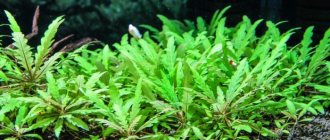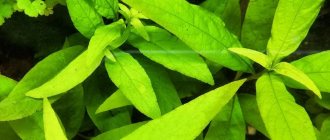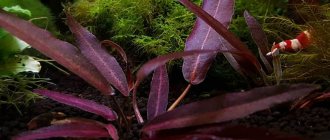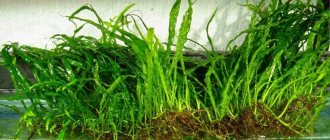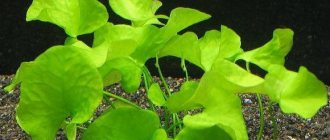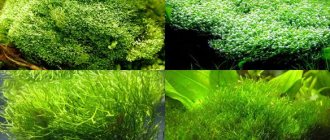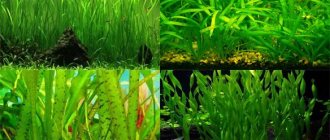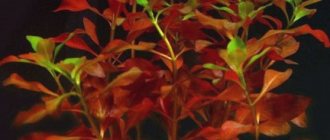The plant forms dense large bushes. Hygrophila leaves are polymorphic, changing their shape during growth. It is because of this that hygrophila received the name changeable or demorphic. How its leaves change:
- in a young plant, the leaf blades have a round or slightly elongated shape;
- then hygrophila develops leaves with jagged edges;
- in an older bush, the leaf blades are strongly divided into segments.
The leaves of adult Hygrophila sinema resemble fern leaves in appearance. The length of the leaf plate varies from 10 to 20 cm, width up to 15 cm.
Leaf segmentation of Higrophila difformis is maintained only when grown in water. If it is transferred to a surface form, the leaf plates will again become rounded and without jagged edges.
The leaves located under water are colored light green, and on the reverse side they have a silver tint. On the stem, the leaf blades are arranged in one line. The leaves of different whorls have a transverse arrangement in relation to each other.
The stems can reach 50 cm in height, but in small aquariums you can often find bushes no more than 30 cm high.
Growing and care
Higrophila difformis has low maintenance requirements, making this plant popular among beginners.
It can be placed in both medium and large aquariums.
Hygrophila sinema also has decorative value - dense thickets of lacy greenery look impressive in the center of an aquarium composition or in the back of the tank.
Many people grow this plant in paludariums or wet greenhouses. It is in the above-water form of hygrophila that the demorph actively blooms. Pink inflorescences form on the shoots of the plant, which can be arranged in groups or individually.
When growing Hygrophila sinema in water, flowers can also form, but only if the stems have grown above the liquid level in the aquarium.
Water parameters for ideal maintenance
Higrophila difformis can grow in water with varying levels of hardness and acidity, but is more demanding of heat. Let us consider in more detail at what hydrochemical parameters the plant will feel comfortable:
- temperature - 22-27ºС;
- hardness - from 4º to 16º;
- acid-base balance - 5.0-8.5.
As practice shows, Hygrophila variablea grows best in soft water at a temperature of 25-27ºС. When the temperature drops to 22º or less, its growth stops completely. You also need to change ¼ volume of water every week.
Lighting requirements
Hygrophila sinema needs bright lighting with an intensity of 50 Lm/l for 10-12 hours. If there is not enough light, its leaves stop growing, its stems become elongated, and the plant overall looks less impressive.
In low light, the leaves of Hygrophila variata remain round, and in large amounts of light they become delicate.
It is advisable to use combined lighting, combining natural light and special lamps.
It would be a good idea to place light sources on the sides of the aquarium. Another feature is that the light flux must be diffused.
Demanding requirements for soil and nutrient substrate
To grow hygrophila sinema, soil is not necessary at all. The plant can live peacefully, floating in the water column.
And for rooting it is better to choose neutral soil with small granules. Quartz, gravel, pebbles are suitable. The recommended soil layer is 5 cm in height.
You can also use nutrient soils containing organic and mineral substances. For example, iron will help the plant maintain its bright green color, and organic matter will serve as a good source of nitrogen and contribute to the active growth of hygrophila. What kind of soil can be placed in an aquarium:
- JBL AquaBasis. Nutrient soil with clay, a source of iron for aquarium plants.
- Gloxy GL-563509. Nutrient substrate that softens water. Helps maintain biological balance in the aquarium.
- Dennerle DeponitMix Professional 9in1. Nutrient substrate with peat, clay, iron chelates and other beneficial substances.
Requirement for fertilizers
Higrophila difformis does not require additional feeding. It can obtain nutrients from water, especially if placed in an aquarium with an established ecosystem. Although, in the presence of fertilizers and carbon dioxide, this representative of the aquatic flora develops much better.
The plant receives its main nutrition through the powerful root system. If hygrophila is planted in neutral soil, you can put a root tablet under the bush. The following drugs are suitable:
Tetra Crypto
Tetra PlantaStart
JBL Ferropol Root
API Root Tabs
Dennerle Power Tabs
Dennerle E15 FerActiv
Intense, long-lasting lighting guarantees good growth of hygrophila
Hygrophiles are passionate fans of direct sunlight, so if this does not cause inconvenience to the other inhabitants of the aquarium, try to place it as close to the window as possible. For additional side lighting, if you want the plant not to shed its lower leaves, you can use incandescent lamps; a good choice is fluorescent lamps with half a watt of power per liter of volume. When providing artificial light with incandescent lamps, the power of the lamp should be three times higher. The duration of daylight should be at least 12 hours. With this lighting, the plant will retain its old leaves for a long time.
Reproduction
You can get new Hygrophila demorphus bushes or update old ones in a simple way - using cuttings. The procedure is quite easy, even for beginners. Let's look at how the process happens.
- The stem is divided into parts with a sharp knife so that there are 3-4 buds in one section.
- Each cutting is not buried too deeply in the ground.
- After some time, the stem will give roots and finally gain a foothold in the soil.
Another option, which many aquarists consider preferable, is to leave the cut cuttings floating in the water column. And when the first roots and leaves appear on these stems, they can already be fixed in the ground.
general description
Hygrophila is a herbaceous plant of the Acanthaceae family, a genus of dicotyledonous flowering plants, which can be an annual or perennial. Although considered a native of Southeast Asia, it grows in warm waters of the tropics and subtropics around the world. In nature, there are from 90 to 100 subspecies of plants; they can be found both under water and on land, where they inhabit the most moist soils. Aquarists use many species of hygrophila to create aquascapes. Lush, bright bushes often become accent pieces in the underwater landscape of aquariums.
Hygrophila has clearly defined stems, leaves and roots. With proper care, the stems and leaves reach a length of 20-35 cm and are distinguished by their bright, rich color. Depending on the type and intensity of lighting, in addition to numerous shades of green, hygrophila can have a reddish and even brown tint.
Particularly unusual coloration is present on the Pinnatifida and Rosanerviga species.
The paired leaves of the plant on short petioles or without them at all in most species have an elongated shape. Each pair of leaves is located on the stem perpendicular to the next pair. Hygrophila naturally grows in bodies of water with a slow flow or even in stagnant water; it loves wetlands, ponds, shallow rivers, and lakes. Thickets of an aquatic plant can be found in well-warmed sunny places, where there is almost no shade and there is a muddy substrate.
Many people prefer to keep Hygrophila in their home aquariums. She feels great at a water temperature of 20 to 30 degrees. Its life support includes the presence of nutritious soil, as well as long-term and bright lighting.
If the water temperature decreases and the light becomes minimal, the life processes of plants freeze and go into saving mode. The longer the Spartan situation lasts, the worse its consequences will be; the development of the bushes will slow down and, although they will survive, they will lose their decorative effect. Where hygrophila lives, aquariums are cleaned less often; it removes nitrogenous compounds from the water, retards the development of harmful microorganisms, takes organic particles and microelements from the environment for its nutrition, thereby cleansing everything around.
But, despite the fact that hygrophila is happy with the mud formation obtained from the waste products of aquarium fish, too dirty water can harm it, namely, lead to rotting of the lower aging leaves. It is advisable to update the water composition by 20% every week.
Variations and forms of the plant
The most common variation of Hygrophila sinema is Hygrophila difformis WeifiGrun. This form is also characterized by variable leaf shape, but has a significant difference in color.
On the carved leaf blades of Hygrophila variales Weiss-Gruen, white veins are clearly visible. Presumably, their formation was once caused by a lack of chlorophyll.
Like the main form, this hygrophila is easy to care for, grows quickly and loves bright light.
Appearance of Hygrophila sinema
The plant is characterized by long stems, the height of which can be from 20 cm to 0.5 m. As Hygrophila difformis develops, the leaves change shape; at a young age they are round and whole, later they take on a pinnately dissected shape. The length of the leaves reaches 15 cm. An adult plant is a tall and lush bush of light green color.
In addition to the underwater part, the plant can develop shoots above the water level. In this case, the leaves have only a solid shape, and fragrant flowers of a light pink hue can form between them.
Hygrophila sinema forms large dense bushes
Lifehacks and tips for aquarists
- Hygrophila sinema can be used as a natural filter. It can be planted in an aquarium with a high content of nitrogen compounds. The plant will actively absorb them and normalize the chemical composition of the water, especially if this is important for neighboring plants.
- If Higrophila difformis is planted not in an old aquarium, but in a new one, it is advisable to add macrofertilizers or sludge from another perennial aquarium. The plant will take nutrients from it. In nature, hygrophila can often be found on the banks of silted rivers.
- A large number of glandular hairs are formed on the surface leaves of Hygrophila. Any damage to the leaf blades releases toxins that can be dangerous to some species of fish. It is important to be careful when working with the plant or trimming it.
Location in the aquarium
Hygrophila loosestrife looks best in the background of the container; it is planted not individually, but in groups. Hygrophila dimorpha looks good near the side walls of the vessel or in the background. Hygrophila polysperma is usually planted in groups along the side and rear walls of the container; it also looks good in the middle ground. Weiss-grün fits perfectly in the second row of plants in the aquarium, as well as in the background. Hygrophila red, with its contrasting green hue, is given a place in the central part of the aquarium and in the background, where it is planted in groups of 8-10 stems.
Hygrophila is an unpretentious and beautiful aquarium plant, suitable for beginner aquarists. In addition to achieving an interesting decorative effect in the aquarium, it is often used as a substrate during fish spawning.
Return to content
